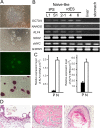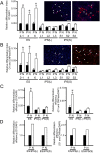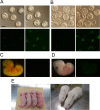Naïve-like conversion enhances the difference in innate in vitro differentiation capacity between rabbit ES cells and iPS cells
- PMID: 25345855
- PMCID: PMC4354226
- DOI: 10.1262/jrd.2014-098
Naïve-like conversion enhances the difference in innate in vitro differentiation capacity between rabbit ES cells and iPS cells
Abstract
Quality evaluation of pluripotent stem cells using appropriate animal models needs to be improved for human regenerative medicine. Previously, we demonstrated that although the in vitro neural differentiating capacity of rabbit induced pluripotent stem cells (iPSCs) can be mitigated by improving their baseline level of pluripotency, i.e., by converting them into the so-called "naïve-like" state, the effect after such conversion of rabbit embryonic stem cells (ESCs) remains to be elucidated. Here we found that naïve-like conversion enhanced the differences in innate in vitro differentiation capacity between ESCs and iPSCs. Naïve-like rabbit ESCs exhibited several features indicating pluripotency, including the capacity for teratoma formation. They differentiated into mature oligodendrocytes much more effectively (3.3-7.2 times) than naïve-like iPSCs. This suggests an inherent variation in differentiation potential in vitro among PSC lines. When naïve-like ESCs were injected into preimplantation rabbit embryos, although they contributed efficiently to forming the inner cell mass of blastocysts, no chimeric pups were obtained. Thus, in vitro neural differentiation following naïve-like conversion is a promising option for determining the quality of PSCs without the need to demonstrate chimeric contribution. These results provide an opportunity to evaluate which pluripotent stem cells or treatments are best suited for therapeutic use.
Figures



Similar articles
-
Naive-like conversion overcomes the limited differentiation capacity of induced pluripotent stem cells.J Biol Chem. 2013 Sep 6;288(36):26157-26166. doi: 10.1074/jbc.M113.502492. Epub 2013 Jul 23. J Biol Chem. 2013. PMID: 23880763 Free PMC article.
-
Discrimination of Stem Cell Status after Subjecting Cynomolgus Monkey Pluripotent Stem Cells to Naïve Conversion.Sci Rep. 2017 Mar 28;7:45285. doi: 10.1038/srep45285. Sci Rep. 2017. PMID: 28349944 Free PMC article.
-
YAP Induces Human Naive Pluripotency.Cell Rep. 2016 Mar 15;14(10):2301-12. doi: 10.1016/j.celrep.2016.02.036. Epub 2016 Mar 3. Cell Rep. 2016. PMID: 26947063 Free PMC article.
-
Embryo-derived and induced pluripotent stem cells: Towards naive pluripotency and chimeric competency in rabbits.Exp Cell Res. 2020 Apr 15;389(2):111908. doi: 10.1016/j.yexcr.2020.111908. Epub 2020 Feb 11. Exp Cell Res. 2020. PMID: 32057751 Review.
-
Generation of rabbit pluripotent stem cell lines.Theriogenology. 2012 Nov;78(8):1774-86. doi: 10.1016/j.theriogenology.2012.06.017. Epub 2012 Aug 24. Theriogenology. 2012. PMID: 22925641 Review.
Cited by
-
bFGF and Activin A function to promote survival and proliferation of single iPS cells in conditioned half-exchange mTeSR1 medium.Hum Cell. 2015 Jul;28(3):122-32. doi: 10.1007/s13577-015-0113-7. Epub 2015 Mar 10. Hum Cell. 2015. PMID: 25754839
-
Development of reproductive engineering techniques at the RIKEN BioResource Center.Exp Anim. 2017 Jan 27;66(1):1-16. doi: 10.1538/expanim.16-0074. Epub 2016 Oct 19. Exp Anim. 2017. PMID: 27760894 Free PMC article. Review.
-
Generation of genetically-engineered animals using engineered endonucleases.Arch Pharm Res. 2018 Sep;41(9):885-897. doi: 10.1007/s12272-018-1037-z. Epub 2018 May 17. Arch Pharm Res. 2018. PMID: 29777358 Free PMC article. Review.
-
Capturing Human Naïve Pluripotency in the Embryo and in the Dish.Stem Cells Dev. 2017 Aug 15;26(16):1141-1161. doi: 10.1089/scd.2017.0055. Epub 2017 Jun 26. Stem Cells Dev. 2017. PMID: 28537488 Free PMC article. Review.
-
Cellular Dynamics of Mouse Trophoblast Stem Cells: Identification of a Persistent Stem Cell Type.Biol Reprod. 2016 Jun;94(6):122. doi: 10.1095/biolreprod.115.137125. Epub 2016 Apr 27. Biol Reprod. 2016. PMID: 27122635 Free PMC article.
References
-
- Honda A, Hirose M, Inoue K, Ogonuki N, Miki H, Shimozawa N, Hatori M, Shimizu N, Murata T, Hirose M, Katayama K, Wakisaka N, Miyoshi H, Yokoyama KK, Sankai T, Ogura A. Stable embryonic stem cell lines in rabbits: potential small animal models for human research. Reprod Biomed Online 2008; 17: 706–715. - PubMed
-
- Graur D, Duret L, Gouy M. Phylogenetic position of the order Lagomorpha (rabbits, hares and allies). Nature 1996; 379: 333–335. - PubMed
-
- Shiomi M, Ito T, Yamada S, Kawashima S, Fan J. Correlation of vulnerable coronary plaques to sudden cardiac events. Lessons from a myocardial infarction-prone animal model (the WHHLMI rabbit). J Atheroscler Thromb 2004; 11: 184–189. - PubMed
-
- Weekers F, Van Herck E, Coopmans W, Michalaki M, Bowers CY, Veldhuis JD, Van den Berghe G. A novel in vivo rabbit model of hypercatabolic critical illness reveals a biphasic neuroendocrine stress response. Endocrinology 2002; 143: 764–774. - PubMed
Publication types
MeSH terms
Substances
LinkOut - more resources
Full Text Sources
Other Literature Sources

